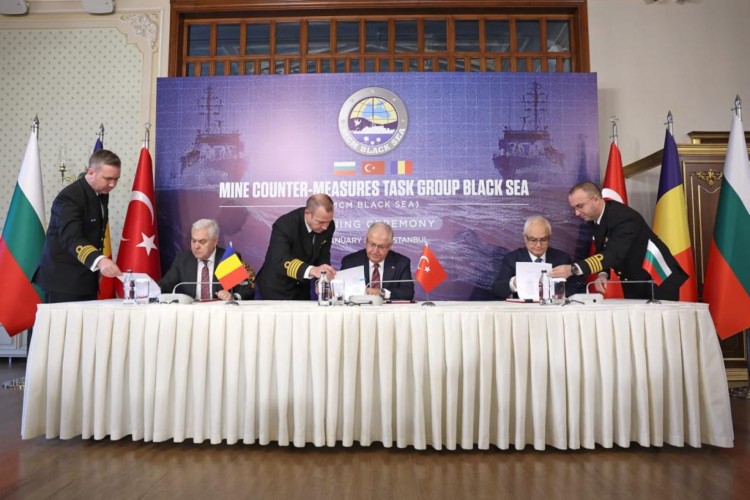NATO Members Collaborate on Black Sea Demining Operation
ISTANBUL, January 11, 2024 — Defence leaders from NATO members Bulgaria, Romania, and Türkiye signed a Memorandum of Understanding on the establishment of the MCM Black Sea aimed at protecting Black Sea shipping from mines laid during Russia’s attack against Ukraine.

The joint initiative, known as the Mine Countermeasures Naval Group in the Black Sea (MCM Black Sea), was initiated by Türkiye in August 2023. The defence ministers, including Türkiye’s Yaşar Güler, Bulgaria’s Atanas Zapryanov, and Romania’s Angel Tîlvăr, signed a memorandum of understanding on January 11, marking a crucial step toward ensuring safe shipping lines in the area.
The MCM Black Sea task force will consist of three mine countermeasures ships – one from each country – and a command-and-control ship. These vessels will deploy for 15 days at least twice every six months. The initiative aims to address the mine threat that emerged after Russia’s aggression against Ukraine, posing risks to the safety of shipping in the Black Sea.
According to the Bulgarian Defence Ministry, the demining operation remains open to collaboration with mine countermeasure forces and assets from other NATO member countries outside the Black Sea region. The partnership is not intended to be directed against any specific country, as the Turkish defence ministry emphasised.
“The activities of the MCM Black Sea initiative are entirely peaceful in nature and are not directed against any other country,” stated the Bulgarian Defence Ministry. “It is expected to help improve interaction and good neighbourly relations between the participants, without replacing NATO’s presence and ongoing deterrence and defence activities in the Black Sea area.”
The signing of the memorandum in Istanbul on Thursday will be followed by an operational planning process to develop detailed documents and instructions for the group’s actions. This process may take several months.
The demining effort comes in response to incidents such as the late December case where a Greek cargo ship sailing in the Black Sea encountered a Russian mine, resulting in a fire and injuries to two sailors. With mines washing up in the Black Sea waters of NATO member states, the initiative aims to ensure safer shipping lanes and ease Ukraine’s efforts to break through the Russian naval blockade.
According to the Romanian Defence Ministry, the rotating command structure of MCM Black Sea is expected to contribute to strengthening the allied posture of deterrence and defence of the eastern flank.
As the collaborative effort unfolds, top defence officials express hopes for successful demining operations, emphasising the peaceful nature of the initiative and its potential to foster improved relations among participating nations.
The Memorandum of Understanding signing ceremony in Istanbul signifies a united front among NATO members to safeguard Black Sea shipping from the remnants of conflict, affirming their commitment to regional stability and security.

Background of the Conflict:
The tensions between Russia and Ukraine escalated dramatically in 2014 when Russia annexed Crimea, a move that drew widespread condemnation and triggered a series of events leading to the ongoing conflict. The Kremlin’s support for the separatists in eastern Ukraine fuelled a protracted and bloody conflict in the Donetsk and Luhansk regions.
The Ukrainian government’s aspirations for closer ties with the European Union and NATO were met with resistance from Moscow, which saw these developments as encroachments on its sphere of influence. The annexation of Crimea and support for separatist forces underscored Russia’s determination to maintain dominance in the region.
Russia’s Aggression and the Black Sea Region:
The Black Sea became a strategic focal point amid the conflict, as Russia sought to assert control over its maritime routes and project power in the face of NATO’s presence in the region. The outbreak of hostilities prompted Russia to mine Ukraine’s Black Sea coastline, creating a hazardous environment for shipping.
Recent incidents, such as a Greek cargo ship encountering a Russian mine, highlight the real and immediate threats posed by these explosive remnants. Russia’s aggressive actions, coupled with its disregard for international agreements, have not only jeopardised the safety of maritime traffic but have also strained diplomatic relations in the region.
Types of Mines and Detection Methods:
The mines deployed vary in type, including both traditional naval mines and improvised explosive devices (IEDs). Detection methods employed by mine countermeasure ships are sophisticated and diverse. Magnetic, acoustic, and pressure-sensitive mines demand specialised technologies for identification. Advanced sonar systems play a pivotal role in scanning the sea floor, enabling the detection of anomalies indicative of buried or semi-buried explosive devices.
Neutralisation Techniques:
Once identified, the process of neutralising mines requires precision and caution. Mine countermeasure ships are equipped with remotely operated vehicles (ROVs) and autonomous underwater vehicles (AUVs) to approach and dispose of the explosive devices safely.
Divers also play a crucial role in demining operations, manually neutralising mines in shallow waters where robotic intervention may be challenging. Controlled detonation is another method employed, ensuring that mines are disposed of safely without causing collateral damage.
Risks and Challenges:
Demining in the Black Sea is not without its perils. The unpredictable nature of sea conditions and the deteriorating state of some mines pose inherent risks to personnel and equipment involved in the operations. Mines may have become unstable over time, making them more prone to accidental detonation during removal.